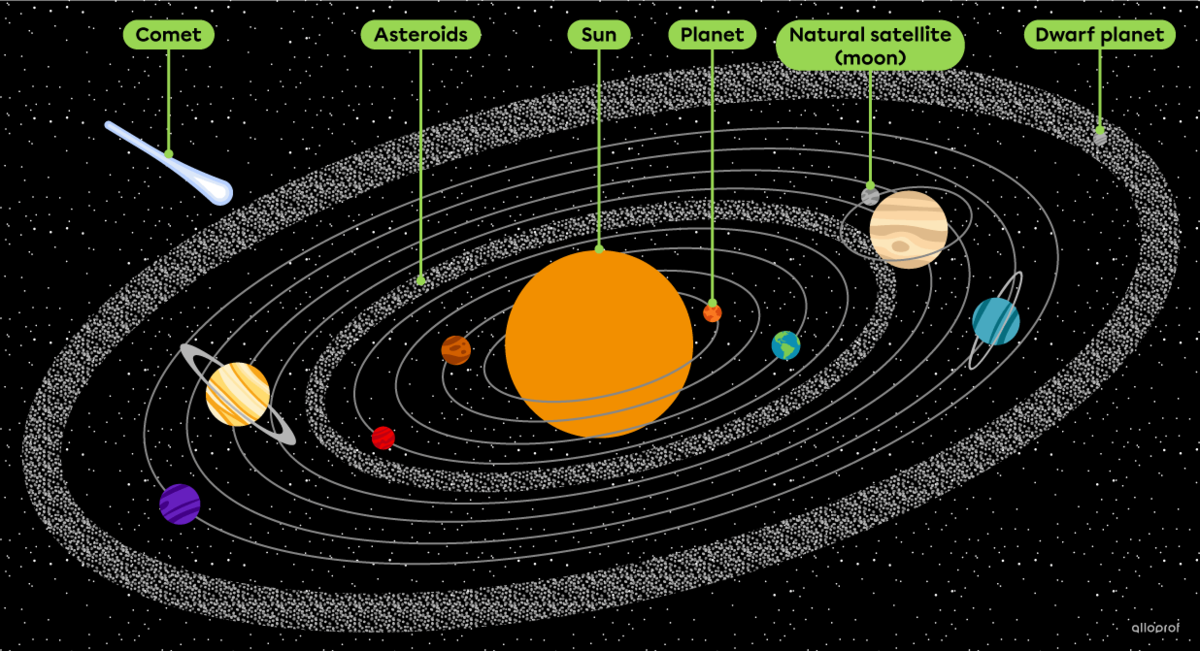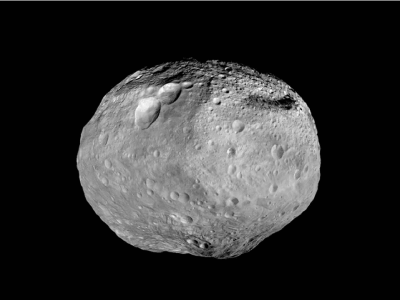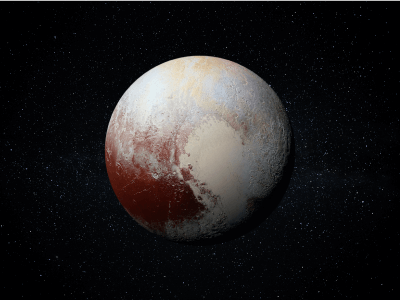The solar system is a system composed of the Sun and all the celestial bodies orbiting it.
A celestial body is a natural object located in space. The celestial bodies in the solar system are the Sun, the eight planets and their natural satellites, several dwarf planets and millions of asteroids, meteoroids and comets.
The solar system is a planetary system, which is a system formed by a star and planets orbiting around it. It is called the solar system because the Latin name for its star – the Sun – is solis. There are many planetary systems in the universe. In our galaxy, thousands of planetary systems have been discovered and it is estimated that there may be hundreds of billions. In the entire Universe, there are probably 100 billion times more!

Notes: The dimensions of the stars and distances are not to scale. Meteoroids are rocks and dust that are too small to be seen in this image.
All the celestial bodies in the solar system are held together by gravity. This force allows planets, asteroids and comets, among others, to remain in orbit around the Sun. It also allows natural satellites to remain in orbit around their planet.
The formation of the solar system started about 4.6 billion years ago. It started as a massive cloud of gas and dust that flattened out to form a giant disc. Due to gravity, most of the gas and dust gathered to form a huge ball in the centre of the disc. This ball became our star, the Sun. The remaining gas and dust also gathered into smaller balls around the Sun to form the eight planets and the dwarf planets. In the same way, smaller balls of matter formed around some planets and became their natural satellites.
When the solar system was formed, only rocky matter was able to tolerate the heat near the Sun. This is why the planets closest to the Sun – Mercury, Venus, Earth and Mars – are telluric, while the furthest planets – Jupiter, Saturn, Uranus and Neptune – are gas giants.

The young star L1527, located approximately 430 light years from Earth, shows what our solar system might have looked like when it formed.
Source: L1527 and Protostar (NIRCam Image) [Online image]. (2022, November 16). NASA, ESA, CSA, STScI. Rights reserved*[1]
|
Type of celestial body |
Star |
|---|---|
|
Diameter at the equator |
110 times longer than Earth’s diameter |
|
Mass |
28 times bigger than Earth's mass |
|
Gravity |
28 times stronger than Earth’s gravity |
|
Rotation period (around its axis) |
Approximately 25 Earth days |
|
Surface temperature |
Approximately 5 500°C |
|
Core temperature |
Approximately 15 000 000°C |
|
Planets in orbit |
8 |
Source: Canadian Space Agency, 2020[2] |
|
The Sun is the star at the centre of our solar system. A star is a giant ball of very hot gases: hydrogen and helium. At the centre of the Sun, these gases undergo nuclear reactions that release a lot of energy in the form of radiation (light, heat, etc.).
The mass of the Sun is responsible for about 99.9% of the total mass of the solar system.
A celestial body has to respect certain conditions to be considered a planet:
-
It has a mostly spherical, or round, shape.
-
It orbits, or revolves, around a star.
-
It does not emit light.
-
It has cleared its orbit and nearby orbits of any other celestial bodies of comparable size, except its natural satellites, or moons.
The eight planets of the solar system are Mercury, Venus, Earth, Mars, Jupiter, Saturn, Uranus and Neptune. They revolve around the Sun.
A dwarf planet is a more or less spherical celestial body that orbits a star and is often in close proximity to celestial bodies of comparable size.
Ceres and Pluto are dwarf planets in the solar system. They are located in asteroid belts. Unlike planets, they are not alone in their orbit. They are surrounded by millions of asteroids.
Ceres lies in the main asteroid belt of the solar system, between Mars and Jupiter. It is the largest object in this belt. It is the only dwarf planet that lies between the Sun and Neptune. The other known dwarf planets lie beyond Neptune, such as Pluto.
Pluto lies in the Kuiper Belt, beyond the orbit of Neptune. It is smaller than the Moon and has five known natural satellites[3].

Source: Ceres Rotation and Occator Crater [Online image]. (2018, April 5). NASA/JPL-CalTech/UCLA/MPS/DLR/IDA, 2018. Rights reserved*[4]
A natural satellite, often called a moon, is a naturally occurring celestial body that orbits a larger celestial body.
Natural satellites in the solar system may revolve around a planet, a dwarf planet or even an asteroid.
To date, more than 200 natural satellites orbiting planets have been discovered in the solar system. Some planets have none, while others have dozens. The Earth has only one natural satellite, called the Moon.
|
Type of celestial body |
Earth’s natural satellite |
|---|---|
|
Average distance from Earth |
384 400 km |
|
Diameter at the equator |
25% of Earth's diameter |
|
Mass |
1% of Earth's mass |
|
Gravity |
6 times weaker than Earth’s gravity |
|
Revolution period (around Earth) |
27.3 Earth days |
|
Rotation period (around its axis) |
27.3 Earth days |
|
Surface temperature |
-248 to 123°C |
Source: Canadian Space Agency, 2022[5] |
|
An asteroid is a small, irregularly shaped celestial body composed of rock, metal and ice, orbiting a star.
Asteroids are spread out throughout the solar system, but they are particularly concentrated in two areas: the asteroid belt, sometimes referred to as the main belt, and the Kuiper belt. The asteroid belt is located between Mars and Jupiter, and the Kuiper belt is located beyond Neptune.

Note: The dimensions of the stars and distances are not to scale.
An asteroid can range in size from less than 1 cm to hundreds of km. The largest known asteroid, Vesta, is 530 km wide[6], but most asteroids are less than 10 m wide.
Vesta, Eros and Ida are three rather large asteroids in the solar system. Vesta is a few hundred km wide, while Eros and Ida are about 30 km wide. Ida even has a natural satellite.

Source: Full View of Asteroid Vesta [Online image]. NASA/JPL-Caltech/UCLA/MPS/DLR/IDA. (2017, August 7). Rights reserved*[7]

Source: PIA03137: A Southern Hemisphere Overview [Online image]. NASA/JPL/JHUAPL, (2001, February 17). Rights reserved*[8]

Source: PIA00136: Asteroid Ida and Its Moon [Online image]. NASA/JPL, (1996, February 1). Rights reserved*[9]
-
L1527 and Protostar (NIRCam Image) [Online image]. (2022, November 16). NASA, ESA, CSA, STScI. Webb Space Telescope, (https://webbtelescope.org/contents/media/images/2022/055/01GGWCXTEXGJ0C…). *Content used by Alloprof in compliance with the Copyright Act in the context of fair use for educational purposes. [https://laws-lois.justice.gc.ca/eng/acts/c-42/page-9.html].
-
Canadian Space Agency. (2020, March 12). The Sun. https://www.asc-csa.gc.ca/eng/astronomy/solar-system/sun.asp
-
NASA. (2021, August 6). Pluto. https://solarsystem.nasa.gov/planets/dwarf-planets/pluto/in-depth
-
Ceres Rotation and Occator Crater [Online image]. (2018, April 5). NASA/JPL-CalTech/UCLA/MPS/DLR/IDA. https://solarsystem.nasa.gov/resources/846/ceres-rotation-and-occator-c… *Content used by Alloprof in compliance with the Copyright Act in the context of fair use for educational purposes. [https://laws-lois.justice.gc.ca/eng/acts/c-42/page-9.html].
-
Canadian Space Agency. (2020, February 11). The Moon. https://www.asc-csa.gc.ca/eng/astronomy/solar-system/moon.asp
-
Canadian Space Agency. (2020, March 12). Comets and asteroids. https://www.asc-csa.gc.ca/eng/astronomy/solar-system/comets-and-asteroi…;
-
Full View of Asteroid Vesta [Online image]. NASA/JPL-Caltech/UCLA/MPS/DLR/IDA. (2017, August 7). https://www.nasa.gov/mission_pages/dawn/multimedia/pia15678.html *Content used by Alloprof in compliance with the Copyright Act in the context of fair use for educational purposes. [https://laws-lois.justice.gc.ca/eng/acts/c-42/page-9.html].
-
PIA03137: A Southern Hemisphere Overview [Online image]. NASA/JPL/JHUAPL, (2001, February 17). https://photojournal.jpl.nasa.gov/catalog/PIA03137 *Content used by Alloprof in compliance with the Copyright Act in the context of fair use for educational purposes. [https://laws-lois.justice.gc.ca/eng/acts/c-42/page-9.html].
-
PIA00136: Asteroid Ida and Its Moon [Online image]. NASA/JPL, (1996, February 1). https://photojournal.jpl.nasa.gov/catalog/PIA00136 *Content used by Alloprof in compliance with the Copyright Act in the context of fair use for educational purposes. [https://laws-lois.justice.gc.ca/eng/acts/c-42/page-9.html].


